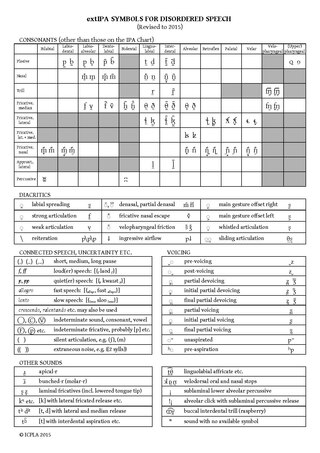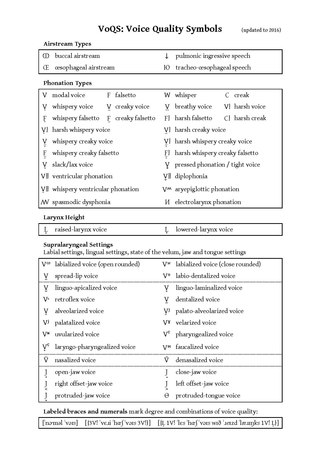Related Research Articles
Approximants are speech sounds that involve the articulators approaching each other but not narrowly enough nor with enough articulatory precision to create turbulent airflow. Therefore, approximants fall between fricatives, which do produce a turbulent airstream, and vowels, which produce no turbulence. This class is composed of sounds like and semivowels like and, as well as lateral approximants like.
A fricative is a consonant produced by forcing air through a narrow channel made by placing two articulators close together. These may be the lower lip against the upper teeth, in the case of ; the back of the tongue against the soft palate in the case of German ; or the side of the tongue against the molars, in the case of Welsh. This turbulent airflow is called frication.

The International Phonetic Alphabet (IPA) is an alphabetic system of phonetic notation based primarily on the Latin script. It was devised by the International Phonetic Association in the late 19th century as a standardized representation of speech sounds in written form. The IPA is used by lexicographers, foreign language students and teachers, linguists, speech–language pathologists, singers, actors, constructed language creators, and translators.
In phonetics, rhotic consonants, or "R-like" sounds, are liquid consonants that are traditionally represented orthographically by symbols derived from the Greek letter rho, including ⟨R⟩, ⟨r⟩ in the Latin script and ⟨Р⟩, ⟨p⟩ in the Cyrillic script. They are transcribed in the International Phonetic Alphabet by upper- or lower-case variants of Roman ⟨R⟩, ⟨r⟩: ⟨r⟩, ⟨ɾ⟩, ⟨ɹ⟩, ⟨ɻ⟩, ⟨ʀ⟩, ⟨ʁ⟩, ⟨ɽ⟩, and ⟨ɺ⟩. Transcriptions for vocalic or semivocalic realisations of underlying rhotics include the ⟨ə̯⟩ and ⟨ɐ̯⟩.
Uvulars are consonants articulated with the back of the tongue against or near the uvula, that is, further back in the mouth than velar consonants. Uvulars may be stops, fricatives, nasals, trills, or approximants, though the IPA does not provide a separate symbol for the approximant, and the symbol for the voiced fricative is used instead. Uvular affricates can certainly be made but are rare: they occur in some southern High-German dialects, as well as in a few African and Native American languages. Uvular consonants are typically incompatible with advanced tongue root, and they often cause retraction of neighboring vowels.
Phonetic transcription is the visual representation of speech sounds by means of symbols. The most common type of phonetic transcription uses a phonetic alphabet, such as the International Phonetic Alphabet.
In phonetics, ejective consonants are usually voiceless consonants that are pronounced with a glottalic egressive airstream. In the phonology of a particular language, ejectives may contrast with aspirated, voiced and tenuis consonants. Some languages have glottalized sonorants with creaky voice that pattern with ejectives phonologically, and other languages have ejectives that pattern with implosives, which has led to phonologists positing a phonological class of glottalic consonants, which includes ejectives.
When used as a diacritic mark, the term dot refers to the glyphs "combining dot above", and "combining dot below" which may be combined with some letters of the extended Latin alphabets in use in a variety of languages. Similar marks are used with other scripts.

The palatal or palato-alveolar clicks are a family of click consonants found, as components of words, only in southern Africa. The tongue is nearly flat, and is pulled back rather than down as in the postalveolar clicks, making a sharper sound than those consonants. The tongue makes an extremely broad contact across the roof of the mouth, making correlation with the places of articulation of non-clicks difficult, but Ladefoged & Traill (1984:18) find that the primary place of articulation is the palate, and say that "there is no doubt that should be described as a palatal sound".
In phonetics, a trill is a consonantal sound produced by vibrations between the active articulator and passive articulator. Standard Spanish ⟨rr⟩ as in perro, for example, is an alveolar trill.
In phonetics, a flap or tap is a type of consonantal sound, which is produced with a single contraction of the muscles so that one articulator is thrown against another.
Implosive consonants are a group of stop consonants with a mixed glottalic ingressive and pulmonic egressive airstream mechanism. That is, the airstream is controlled by moving the glottis downward in addition to expelling air from the lungs. Therefore, unlike the purely glottalic ejective consonants, implosives can be modified by phonation. Contrastive implosives are found in approximately 13% of the world's languages.

The International Phonetic Alphabet was created soon after the International Phonetic Association was established in the late 19th century. It was intended as an international system of phonetic transcription for oral languages, originally for pedagogical purposes. The Association was established in Paris in 1886 by French and British language teachers led by Paul Passy. The prototype of the alphabet appeared in Phonetic Teachers' Association (1888b). The Association based their alphabet upon the Romic alphabet of Henry Sweet, which in turn was based on the Phonotypic Alphabet of Isaac Pitman and the Palæotype of Alexander John Ellis.
The Uralic Phonetic Alphabet (UPA) or Finno-Ugric transcription system is a phonetic transcription or notational system used predominantly for the transcription and reconstruction of Uralic languages. It was first published in 1901 by Eemil Nestor Setälä, a Finnish linguist.

The Extensions to the International Phonetic Alphabet for Disordered Speech, commonly abbreviated extIPA, are a set of letters and diacritics devised by the International Clinical Phonetics and Linguistics Association to augment the International Phonetic Alphabet for the phonetic transcription of disordered speech. Some of the symbols are used for transcribing features of normal speech in IPA transcription, and are accepted as such by the International Phonetic Association.
The International Phonetic Alphabet (IPA) possesses a variety of obsolete and nonstandard symbols. Throughout the history of the IPA, characters representing phonetic values have been modified or completely replaced. An example is ⟨ɷ⟩ for standard. Several symbols indicating secondary articulation have been dropped altogether, with the idea that they should be indicated with diacritics: for is one. In addition, the rare voiceless implosive series has been dropped.
IPA Braille is the modern standard Braille encoding of the International Phonetic Alphabet (IPA), as recognized by the International Council on English Braille.

Dania is the traditional linguistic transcription system used in Denmark to describe the Danish language. It was invented by Danish linguist Otto Jespersen and published in 1890 in the Dania, Tidsskrift for folkemål og folkeminder magazine from which the system was named.

Voice Quality Symbols (VoQS) are a set of phonetic symbols used to transcribe disordered speech for what in speech pathology is known as "voice quality". This phrase is usually synonymous with phonation in phonetics, but in speech pathology encompasses secondary articulation as well.
References
- 1 2 WIELD's Recommended Americanist Transcription System
- ↑ ⟨ʔ⟩ is often rendered by removing the dot from a question mark ⟨?⟩.
- ↑ Phonetic Symbol Guide, 2nd ed., p. 301–302
- ↑ Kurath, Hans (1939). Handbook of the Linguistic Geography of New England. Brown University. p. 123.
- ↑ Boas, Goddard, Sapir & Kroeber (1916) Phonetic Transcription of Indian Languages: Report of Committee of American Anthropological Association. Smithsonian Miscellaneous Collections 66.6. Chart is a fold-out behind the back cover that is not reproduced at this link.
- ↑ There is no small-capital delta in Unicode. A full capital would normally be substituted.
- ↑ Not supported by Unicode. It can be kept distinct in a database as Greek Ν, but that is not visually distinct in print.
- ↑ Small-capital engma is rendered various ways. ⟨ᴎ⟩ is the form it takes in the Uralic Phonetic Alphabet and is the form supported by Unicode.
- ↑ P. W. Schmidt, P. G. Schmidt and P. J. Hermes, "Die Sprachlaute und ihre Darstellung in einem allgemeinen linguistischen Alphabet (Schluß) / Les sons du langage et leur représentation dans un alphabet linguistique général (Conclusion)", Anthropos, Bd. 2, H. 5. (1907), insert at page 1098
- ↑ Mithun, Languages of Native North America, 1999, p. viii.
- ↑ Sturtevant, Handbook of North American Indians, vol. 17, 1978, p. 12ff